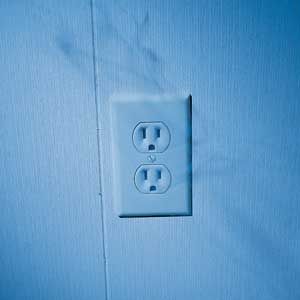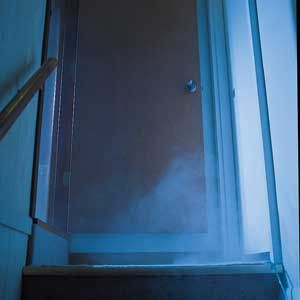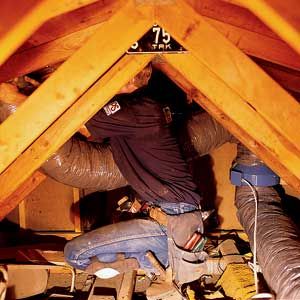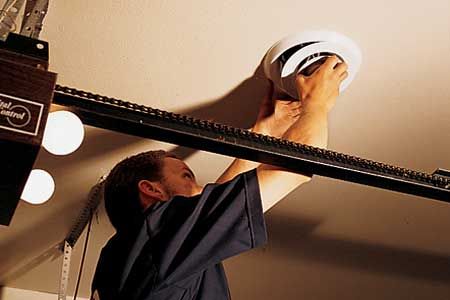
The nightmare began on an ordinary November night in an ordinary house in central Iowa. Jim and Kristi Gubbels were in the basement of their 1960s ranch when, seemingly out of the blue, their new carbon monoxide detector went off. Both felt fine, so they simply reset the detector. After it sounded again, Jim called a heating contractor.
The contractor spent a couple hours testing the furnace and water heater but couldn’t find the source of the gas. Then, as he was packing his tools, his detector showed carbon monoxide levels above 70 parts per million in the house. That’s eight times the allowable federal level for outdoor air. Most firefighters responding to a carbon monoxide call would enter with gas masks if they detected that amount at the front door.
“Jim,” the contractor said, “you guys shouldn’t stay in the house tonight.”
By then Kristi’s lips were tingling, and Jim’s eyes burned. They worried that their
2-year-old, Nick, was in trouble too. So they woke him around midnight and headed to the hospital, where tests revealed all three had slightly elevated carbon monoxide levels in their blood. They were given pure oxygen to breathe.
All the next week, while the family camped out with Kristi’s parents, Jim racked his brain trying to figure out the source of the carbon monoxide. After reading his water-heater manual, he thought he had solved the mystery: He added more rise to the vent. The family moved back home, and Jim bought a better detector that gives instantaneous readouts. Everything seemed fine — until Kristi, who runs a desktop publishing business out of an office in the basement, noticed levels on the detector had climbed past 20 ppm.
“I was absolutely frustrated,” Jim recalls. “I was thoroughly mad.”
In the weeks that followed, the local gas company visited three times but found nothing. Another heating contractor said the eight-year-old furnace had a cracked heat exchanger (it didn’t) and advised Jim to buy a new furnace. Meanwhile, the new detector went up one day to 77 ppm.
Shortly after New Year’s, a friend suggested Kristi call Tom Greiner at the Iowa State Extension Service. Greiner has a Ph.D. in engineering; he also has a reputation for relentless investigation of carbon monoxide problems. After half a dozen visits to the Gubbels’ home, Greiner made a startling discovery: The carbon monoxide in the house was coming from the garage.

All Over America
Every morning in America, where some 30 million houses have attached garages, homeowners open the garage door and start the car. On cold winter mornings, while waiting for the engine to warm, they kill a few minutes adjusting mirrors, flicking a soggy corn flake off a shirt — or go back in the house to retrieve a briefcase or a toddler. Finally, they back out and close the door, not realizing this morning ritual is enough to pose potential health hazards for the family. Even if that huge garage door is open while the car warms up, the air dynamics of a house are likely to suck carbon monoxide inside.
No one can afford to be blase about carbon monoxide. A colorless, odorless gas that weighs the same as air, it is the nation’s number one poison, having killed 11,547 people between 1979 and 1988, reports the federal Centers for Disease Control. (The runner-up poison, heroin, killed half as many.) And the total doesn’t include the 3,000 suicides from inhalation of carbon monoxide annually, or the estimated 10,000 Americans who visit emergency rooms each year with symptoms of carbon monoxide poisoning. Carbon monoxide in the workplace has been a concern for decades, but worries shifted to the home only recently, after inexpensive detectors became widely available. Now 16 million homes have them — and alarms are going off all across the country, often for no discernible reason. Fire departments and gas companies complain of spending so much time on false alarms they don’t have time for real emergencies.
In Minneapolis, carbon monoxide calls to the gas utility, Minnegasco, jumped from 5,000 to 13,000 to more than 21,000 over the past three winters. The company sent inspectors each time, but four out of five times they found nothing amiss. So in late 1995 the utility hired Steve Klossner, a “house diagnostician” from Lakeland Shores, Minnesota. Were there indeed sources of carbon monoxide great enough to set off all these alarms? Or were the detectors flawed? During the 1995-96 heating season, Klossner called on 50 Minnegasco customers whose alarms had sounded at least twice for no apparent reason. Klossner used sophisticated equipment, spent hours at each house and emerged with a surprise: In 34 of the 50 houses, the problem wasn’t one of the usual suspects — a dirty furnace burner, a blocked flue or a gas water heater with too little draw in its exhaust vent. Nor was it a faulty detector. In three out of four cases, the source was an attached garage.
The protocol was this: Klossner would arrive at each house in the morning, open the garage door, start the homeowner’s cold car, let it idle for 45 seconds, then shut it off and close the door. In winter, when cold internal combustion engines can’t burn fuel efficiently, those 45 seconds were enough to fill the garage with carbon monoxide. Over the next few hours, the gas typically got sucked into the house. By noon, more carbon monoxide was in the house than in the garage. In one house, Klossner recorded 85 ppm in a child’s bedroom.
Air flow through houses is subtle but persistent, particularly in winter. When inside air is warmer than outside air, it rises and escapes — exfiltrates — through cracks around windows, attic stairs and plumbing vents. Because nature abhors a vacuum, escaping air is replaced by outside air that enters — infiltrates — through similar cracks lower down on the house. This natural air movement is called the stack effect. Add a roaring fireplace, a bathroom fan, a rangetop grill or a clothes dryer, plus a furnace that’s sending hot gases up the flue, and the house needs to suck in even more outside air. Klossner found that his 50 houses drew an average of one-fourth of their outside air from the attached garage. One house drew only 2 percent, and one drew a startling 85 percent.
After Klossner completed the study, his liaison at Minnegasco, Matt Wilber, manager of codes and standards, made a short video demonstrating the garage-to-house connection. Wilber borrowed a house with a two-bay tuck-under garage in Burnsville, Minnesota. He put a theatrical smoke generator in the garage and filmed the smoke as it seeped into the house around trim moldings, floor registers and switchplates. In half an hour, every room in the house was smoky. Yet outside on the driveway, nothing emerged from behind the closed garage door.

Detectors Save Lives
Jim and Kristi Gubbels had bought a carbon monoxide detector only two weeks before that November night when it went off and sent them packing. They got it because Kristi had been complaining of daily headaches. “They were right-between-the-eyes things,” she says. “By eleven or twelve o’clock every day, they were just atrocious.” After she breathed pure oxygen in the hospital, she says, “it was the best I’d felt in a long time. I was a whole new person.”
Carbon monoxide wreaks havoc in the body because it latches onto hemoglobin, the component in blood that carries oxygen to cells. Carbon monoxide binds to hemoglobin with 240 times more sticking power than oxygen. Soon cells can’t get the oxygen they need. A headache is one classic early symptom of carbon monoxide poisoning; fatigue, nausea and dizziness are others. Higher concentrations cause increasingly serious symptoms, from disorientation to unconsciousness. Death comes within a few hours at 500 ppm, within minutes at 10,000 ppm.
What happens to people like Kristi Gubbels, who breathe lower levels over longer periods — doses less than 100 ppm over the course of months? Medical scientists are uncertain, but there are increasing concerns. A 1995 study of people in seven American cities showed that when outdoor levels of carbon monoxide rose just 10 ppm, hospital admissions for congestive heart failure also rose — by 10 to 37 percent. A just-published 11-year study of 10 Canadian cities by the government health agency has made a similar finding: Hospitalizations of elderly people for heart failure climbed 16.5 percent when outdoor levels rose from zero to just 8 ppm.
Some researchers claim low levels cause a syndrome called chronic carbon monoxide poisoning, marked by constant fatigue, irritability and difficulty in concentrating, organizing and forming new memories. But a cause-and-effect relationship is difficult to prove. “There’s nothing real definite,” says Edward P. Krenzelok, director of the Pittsburgh Poison Center and president of the American Academy of Clinical Toxicology. He notes that some people are affected by low levels while others tolerate very high levels. “Who knows what everybody’s individual threshold is? The one thing you can say is, you don’t need carbon monoxide in your body.”
The Gubbels discovered the source of their carbon monoxide problems after Tom Greiner borrowed a $5,800 modular gas analyzer from Iowa State’s mechanical engineering department one night last January. Jim started Kristi’s 1991 sedan in the garage, let the motor run two minutes, then drove the car out and closed the garage door. The garage air registered 575 ppm.
But was it getting into the house? On his next visit, Greiner asked the family to stay with Kristi’s parents, then staged a worst-case scenario. He started the car in their garage and let it run for eight minutes with the garage door closed. Then he backed out and quickly closed the door again. In half an hour, carbon monoxide levels in the house went from zero to 70 ppm. Thirteen hours later, the reading was still 30 ppm.
That cinched it. The cause of all the alarms and late-morning headaches was Kristi’s morning ritual. She would open the garage door, start the car, then come back inside, get Nick, put him in his car seat, drive him off to a sitter and return home to work in her basement office. Air dynamics did the rest. The coldest mornings are when cars produce the most carbon monoxide, when everyone lets the car warm up the longest and when the stack effect inside the house is greatest. “Anybody who has an attached garage has the same problem,” Jim says. “They just don’t know it yet.”
After the discovery, Kristi changed her morning routine. She would get in the car and put it in neutral. Because the garage floor is slightly inclined, the car would roll out onto the driveway. She’d close the garage door and start the car outside.
Says Jim, “Our detector has been reading zero ever since.”

Good Venting
Is that the answer? Should we all be rolling our cars out of our garages? Steve Klossner has tested three other ideas: passive ventilation up high — installing roof vents in the garage attic; passive ventilation down low — replacing two panels in the garage door with louvers; and mechanical ventilation — placing a simple 150-cfm tube fan so it pushes air from the garage ceiling out a vent in an exterior wall, just like a clothes dryer or powder room would be vented.
Klossner concluded louvers didn’t work. When he compared the other options on the test house with 85 ppm in a child’s bedroom, the $100 roof-vent job and the $250 tube-fan fix worked equally well. Both brought the house’s carbon monoxide reading below 8 ppm. But roof vents are an option only on houses with a garage open clear to the rafters; houses with a ceiling in the garage need a fan. The fan can be connected to a switch and a timer, or left running (at a cost of about 12 cents a day where electric rates are 6 cents per kilowatt hour).
To see how such a fan might be installed, This Old House magazine asked Klossner and Greiner to fix the Gubbels residence too. There, ironically, the job came to more than $2,000 — complicated by the fact that because Jim has worked so hard to insulate, weather-strip, caulk and replace windows, the house is very tight. Greiner had measured 0.17 air changes per hour, whereas most houses undergo nearly half an air change each hour.
Greiner and Klossner worried that installing just a roof vent or tube fan in the garage might rob the house of the makeup air it needs. When a house can’t get enough makeup air, bad things happen: A fireplace or clothes dryer might suck air from the furnace or water heater flue, causing a backdraft of combustion fumes (including carbon monoxide) into the house. Nine of the 50 homes in the Minnegasco study had backdraft problems, and in most of those nine the backdrafting produced a burst of carbon monoxide exceeding 4,000 ppm at the source.
So, much to Jim’s initial dismay, a six-inch hole was cut in the side of his house to provide makeup air for both the furnace and water heater. A powered vent was installed on the water heater. In the garage, two ceiling vents were ducted to a fan that pushes air through a roof vent.
When all the holes, ducts and fans were in place, Klossner and Greiner again filled the garage with theatrical smoke. It was soon billowing above the roof — but this time none came into the house. The fan, set at 300 cfm, provided just enough pull to change the air dynamics of the house. The garage is still attached to the house, but in terms of air flow, it might as well be halfway down the block. Jim even cracked the door to the house several inches; the smoke stayed in place. “It was really impressive,” he says. “The smoke was like a wall.”
Most homes do not require such an elaborate solution. Regardless, every home should have a carbon monoxide detector with a digital display — ideally, one on each level. If you see readings well above 10 or 20 parts per million, call a heating contractor or your local gas company to have every combustible appliance checked out. If all other causes are ruled out but high readings persist, try starting the car out of the garage. Or vent your garage by opening a window. Still having a problem? Then call in a specialist in building diagnostics.
Another winter is on its way — and as usual, hundreds of Americans will die from carbon monoxide poisoning. Thousands more will suffer from its effects, but not those who understand the danger that lurks in their garages.
